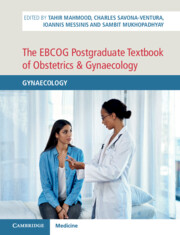Book contents
- The EBCOG Postgraduate Textbook of Obstetrics & Gynaecology
- The EBCOG Postgraduate Textbook of Obstetrics & Gynaecology
- Copyright page
- Dedication
- Contents
- Videos
- Contributors
- Preface
- Section 1 Basic Sciences in Gynaecology
- Section 2 Menstrual Disorders
- Section 3 Reproductive Endocrinology and Infertility
- Section 4 Contraception and STIs
- Section 5 Post-Reproductive Care
- Section 6 Vulva and Vagina
- Chapter 29 Vulvodynia
- Chapter 30 Benign Vulvar Disorders
- Chapter 31 Non-infectious Benign Vaginal Conditions
- Chapter 32 Vulvar Malignancies
- Section 7 Cervix
- Section 8 Uterus
- Section 9 Ovary and Fallopian Tubes
- Section 10 Operative Gynaecology
- Section 11 Public Health Issues in Gynaecology
- Section 12 Miscellaneous
- Index
- Plate Section (PDF Only)
- References
Chapter 29 - Vulvodynia
from Section 6 - Vulva and Vagina
Published online by Cambridge University Press: 24 November 2021
- The EBCOG Postgraduate Textbook of Obstetrics & Gynaecology
- The EBCOG Postgraduate Textbook of Obstetrics & Gynaecology
- Copyright page
- Dedication
- Contents
- Videos
- Contributors
- Preface
- Section 1 Basic Sciences in Gynaecology
- Section 2 Menstrual Disorders
- Section 3 Reproductive Endocrinology and Infertility
- Section 4 Contraception and STIs
- Section 5 Post-Reproductive Care
- Section 6 Vulva and Vagina
- Chapter 29 Vulvodynia
- Chapter 30 Benign Vulvar Disorders
- Chapter 31 Non-infectious Benign Vaginal Conditions
- Chapter 32 Vulvar Malignancies
- Section 7 Cervix
- Section 8 Uterus
- Section 9 Ovary and Fallopian Tubes
- Section 10 Operative Gynaecology
- Section 11 Public Health Issues in Gynaecology
- Section 12 Miscellaneous
- Index
- Plate Section (PDF Only)
- References
Summary
Vulvodynia is a persistent, idiopathic, and multifactorial vulval pain. It presents a challenge to healthcare providers, mainly because it is a complex syndrome that requires interdisciplinary skills, especially in the neurobiological and algological fields, to avoid incorrect pathogenetic interpretations, inaccurate diagnosis and inadequate treatment.
From a neurobiological perspective, vulvodynia is a dysfunctional vulval pain caused by abnormal function of the nervous system itself, not related to a specific vulval disorder responsible for inflammatory pain, or a neural lesion responsible for neuropathic pain.
Provoked vestibulodynia is the most prevalent subtype of vulvodynia, followed by spontaneous generalized vulvodynia. The primary diagnostic goal is to determine whether the woman suffers from vulvodynia as dysfunctional pain opposed to inflammatory or neuropathic pain.
Treatment of vulvodynia requires an individually tailored and multimodal therapeutic approach, that includes counselling, psychological therapy, medical treatment, and physiotherapy. Surgery can be proposed only as a last resort in provoked vestibulodynia.
Keywords
- Type
- Chapter
- Information
- The EBCOG Postgraduate Textbook of Obstetrics & GynaecologyGynaecology, pp. 237 - 246Publisher: Cambridge University PressPrint publication year: 2021

